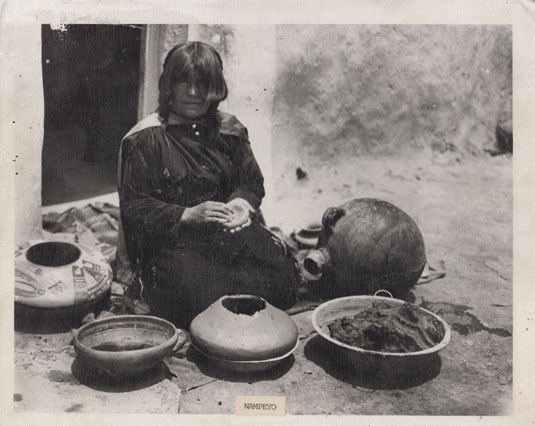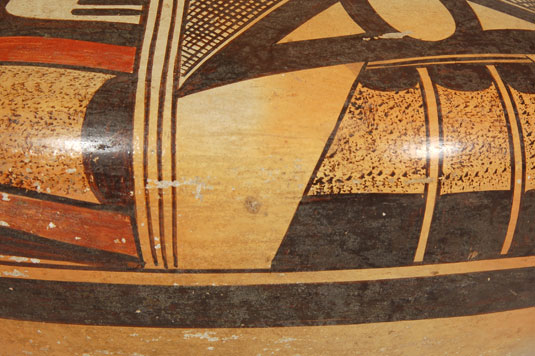Beautiful Sikyatki Revival Vessel Shape Hopi-Tewa Jar [SOLD]
+ Add to my watchlist Forward to Friend
- Category: Historic
- Origin: Hopi Pueblo, Hopituh Shi-nu-mu
- Medium: clay, pigment
- Size: 6-5/8” height x 11-1/4” diameter
- Item # C3823 SOLD
 We are often asked by clients to explain the meaning of designs on pottery. Some designs are relatively easy to interpret but others may or may not be identifiable and related to something with which we are familiar. We have a good escape route in Nampeyo of Hano pottery because we remind clients that designs used by Nampeyo were based on potsherds being excavated at a prehistoric site that existed a thousand years ago. Even if we think we can interpret a design, it may not be what the potter had in mind a thousand years ago. Also, Nampeyo used the potsherds for inspiration, not for copying.
We are often asked by clients to explain the meaning of designs on pottery. Some designs are relatively easy to interpret but others may or may not be identifiable and related to something with which we are familiar. We have a good escape route in Nampeyo of Hano pottery because we remind clients that designs used by Nampeyo were based on potsherds being excavated at a prehistoric site that existed a thousand years ago. Even if we think we can interpret a design, it may not be what the potter had in mind a thousand years ago. Also, Nampeyo used the potsherds for inspiration, not for copying.
We feel confident enough to attribute pottery as having been made by Nampeyo because there is a certain style to the vessel shape and a recognizable style to the painted design. We may not be able to interpret the design, but we can recognize it as one used by her almost a hundred years ago.
The vessel shape of this jar is most decidedly one used many times by Nampeyo. It is based on a shape derived from the ancestral Sikyatki Pueblo. The very minor flare at the rim is seen in many Nampeyo jars. The wide framing lines on top and below the design section are a style she used to set aside the area of her planned design.
There are basically two design panels that are separated from each other by red triangles outlined in black. Each design is divided into three section. The middle section was executed in brown paint and is a variation of the split tail design seen on Nampeyo family pottery. The two design panels that bookend the main one are mirror images of each other and each features the long curved red element seen on many Nampeyo jars in various interpretations. That curved red element is framed by a curved brown one and together they surround an area of stippling, often seen in Nampeyo pottery.
This is an early 20th century creation by Nampeyo of Hopi Pueblo, made and painted while her eyesight was still quite good. The painting was precise and beautifully rendered. The firing was carried out perfectly, yielding a slight orange blush to the finish.
Condition: the upper half of the jar is in very good condition, but the underbody slip has worn away from prior use, probably storing water. Fortunately, the loss is restricted to the area under the design.
Provenance: this Beautiful Sikyatki Revival Vessel Shape Hopi-Tewa Jar is from a family in Santa Fe
Recommended Reading: Canvas of Clay: Seven Centuries of Hopi Ceramic Art by Edwin L. Wade and Allan Cooke
Nampeyo Image: We are appreciative to Hopi-Tewa potter, Mark Tahbo, for sharing this photograph with us. The photograph was recently found in a burned-out home at First Mesa. This image was later identified as having been taken on July 8, 1913, by photographer Joseph K. Dixon. It is part of the Wanamaker Collection of American Indian Photographs at the Mathers Museum of World Cultures, Indiana University, catalog #1962-08-3279.

- Category: Historic
- Origin: Hopi Pueblo, Hopituh Shi-nu-mu
- Medium: clay, pigment
- Size: 6-5/8” height x 11-1/4” diameter
- Item # C3823 SOLD



